Hoop Student is an information site that contains basic concepts about different offensive/defensive strategies and tactics as well as other related topics within the game of basketball.
To get started, there are a few links below to various basketball offensive/defensive strategies and other topics.
However, more links could be found within the Offense and Defense web pages as well.
Basketball Cuts

Basketball cuts consists of skilled action that occurs when a player without possession of the ball uses a specific action to move from one location on the court to another with the primary purpose of creating space and getting open from a defender.
Notable basketball cuts include the backdoor cut, the Iverson cut, and the split cut, among others.
The backdoor cut consists of offensive action that occurs when a player without possession of the basketball seeks to get open, typically by way of an initial quick step towards a player with the ball, followed by an immediate cut to the basket.
The Iverson cut consists of action that occurs when an offensive player who is initially on one side of the court, usually near a wing area, cuts through to the other side, which is typically the opposite wing area, ultimately to get open and receive the basketball.
The split cut comprises action that occurs when a perimeter player, usually near the wing area on the court, passes the basketball to a low post player and afterwards, that same perimeter player cuts away from the post, typically to set or receive a screen.
Basketball Screens

Basketball screens consists of skilled action that occurs when at least one offensive player attempts to block or delay a defender, primarily to create space as well as separation for another offensive player who could use the screen to get open for scoring or playmaking opportunities.
Notable basketball screens include the back screen, down screen, and flare screen, among others.
The back screen consists of action that occurs when one offensive player is able to set a screen behind a defender who is guarding a second offensive player and after that, the second offensive player could then use that screen to get open, particularly near the basket, for a potential scoring opportunity.
The down screen consists of action that occurs when one offensive player faces the general direction of the baseline to set a screen on a defender who is guarding a second offensive player. Following that, the second offensive player can then use the down screen to get open for a possible scoring or playmaking opportunity.
The flare screen comprises action that occurs when one offensive player, being guarded by a defender, cuts away from the basketball to use a screen that is set by a second offensive player and afterwards, the first offensive player could then receive the ball, particularly near the perimeter areas of the court.
Fast Break
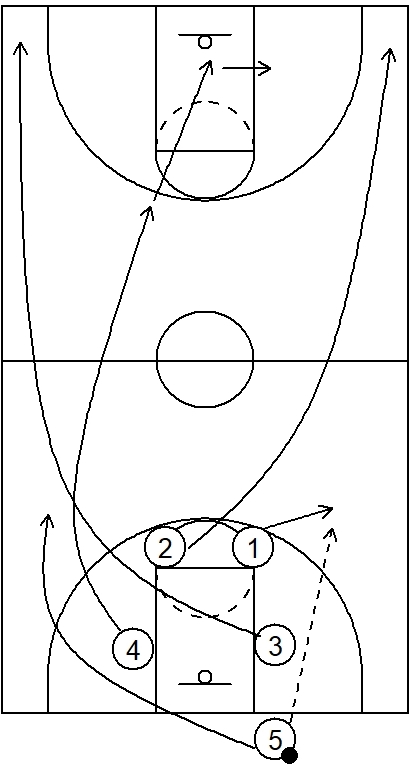
A fast break features offensive action that occurs when a team gains possession of the basketball and then attempts to quickly score points, primarily before the opposing team is able to fully prepare their respective defensive strategies.
Notable fast break strategies include the primary break, secondary break, and numbered fast break.
The primary break is a basketball offensive strategy as well as the initial fast break phase of transition offense and its main objective is to create scoring opportunities, particularly when the defensive team is at a disadvantage from a numbers perspective, generally within the first two or three seconds after gaining possession of the basketball.
The secondary break is a basketball offensive strategy as well as the alternative fast break phase of transition offense which includes scoring options near the basket or near the perimeter areas immediately after the defensive team prevents the initial primary fast break action.
The numbered fast break is a basketball offensive strategy in which each of the five players, during transition offense, are assigned distinct numbers and given specific roles related to those numbers with the main objective of creating quick scoring opportunities near the basket or near the perimeter areas of the court.
Horns offense
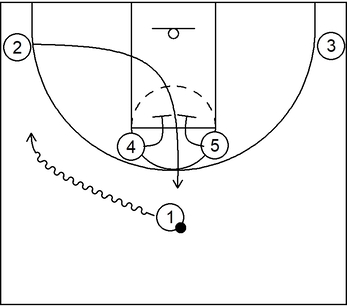
The Horns offense is a basketball offensive strategy that emphasizes spacing to create scoring opportunities near the basket or near the perimeter areas of the court by way of various actions such as basketball screens and dribble handoffs.
One particular advantage of the Horns offense is that it opens up the low post areas, which could potentially keep the low post defenders of the opposing team away from the basket.
As a result, that could create scoring options by way of basketball cuts, dribble drive action and/or via kick passes to three-point shooters.
Furthermore, opening up the low post areas could be particularly helpful for an undersized basketball team or against defensive teams with above average shot blockers.
Motion offense
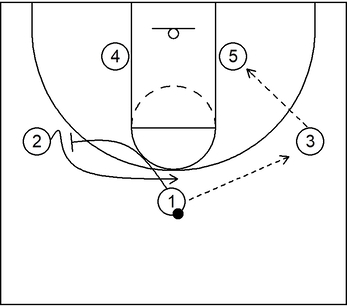
Motion offense is a basketball offensive system that primarily utilizes at least one of the fundamental elements of passing, cutting, screening, or dribbling while also incorporating player movement and ball movement to create scoring opportunities near the basket or near the perimeter areas of the court.
Notable types of motion offenses include the 3 out 2 in motion offense, the 4 out 1 in motion offense, and the 5 out motion offense.
The 3 out 2 in motion offense is a basketball offensive strategy that begins with three offensive players located at the top and near the wings respectively and two additional offensive players which fill the low post blocks on each side of the basket.
The 4 out 1 in motion offense is a basketball offensive strategy that begins with four perimeter players positioned beyond the three point line near the slots as well as the wings or corners respectively. Furthermore, another player, usually a traditional post player fills the low post area or high post area.
The 5 out motion offense is a basketball offensive strategy that begins with five offensive players which fill the top, the wings, and the corners. Additionally, the 5 out motion offense is generally easy to teach, especially at the youth basketball level.
Princeton offense
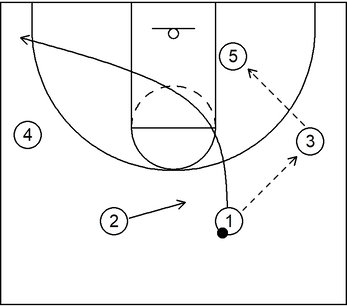
The Princeton offense is a basketball offensive strategy that utilizes the fundamental skills of cutting, dribbling, passing, screening, and shooting as well as three unique series of actions known as Chin, Low and Point to create scoring opportunities near the basket or from the perimeter.
Some key principles of the Princeton offense include maintaining good spacing, controlling tempo, and being patient, among others.
Triangle offense
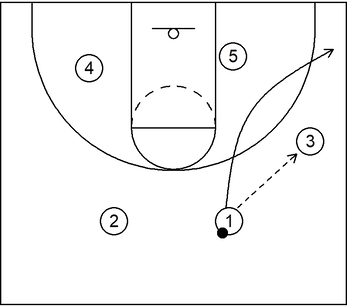
The triangle offense is a basketball offensive strategy that primarily consists of three players forming a sideline triangle on one side of the court to create scoring opportunities via the use of various actions such as ball movement, basketball cuts, and basketball screens, mainly based on the reactions of the defense.
The initial setup for the triangle offense usually consists of a two guard front near the top, a wing player and low post player on the same side as well as a weak side forward opposite the low post player near the short corner area.
Man to man defense
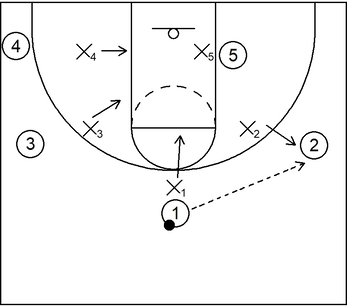
Man to man defense is a type of basketball defensive system that emphasizes each defender guarding a certain offensive player, typically based on their respective basketball positions, to ultimately limit or prevent scoring opportunities near the basket or near the perimeter areas of the court.
Notable variants of man to man defense include the pack line defense and the run and jump defense.
The pack line defense is a basketball defensive strategy that implements on-ball defensive pressure and off-ball actions in which defenders will either sag into the pack line or deny passing lanes to limit or prevent offensive scoring opportunities.
The run and jump defense is a basketball defensive strategy that utilizes man to man principles, defensive sideline traps, and the defensive switch tactic to disrupt offensive flow which could result in potential turnovers or limited scoring opportunities near the basket or near perimeter areas of the court.
Zone defense
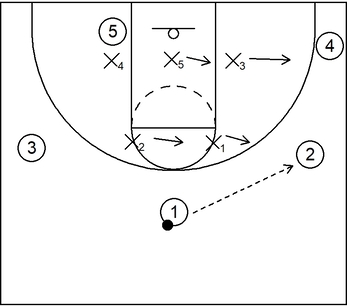
Zone defense is a specific type of basketball defense that consists of each defender guarding a certain area on the court and by extension, any offensive player that enters into that zone defender’s respective area.
Notable types of zone defenses include the 1-1-3 zone defense, the 2-3 zone defense, and the 3-2 zone defense, among others.
The 1-1-3 zone defense is a basketball defensive strategy that seeks to prevent low post scoring opportunities while influencing contested field goal attempts and limiting dribble penetration with on-ball pressure, particularly near the top or wing areas of the court.
The 2-3 zone defense is a basketball defensive strategy that seeks to limit dribble penetration, influence contested perimeter jump shots, and decrease offensive scoring opportunities, particularly from the low post areas, while executing adequate on-ball defense.
The 3-2 zone defense is a basketball defensive strategy that emphasizes the prevention of low post scoring opportunities while restricting dribble penetration with adequate on-ball defense and influencing poor shot selection, particularly near the perimeter areas of the court.
Full court press
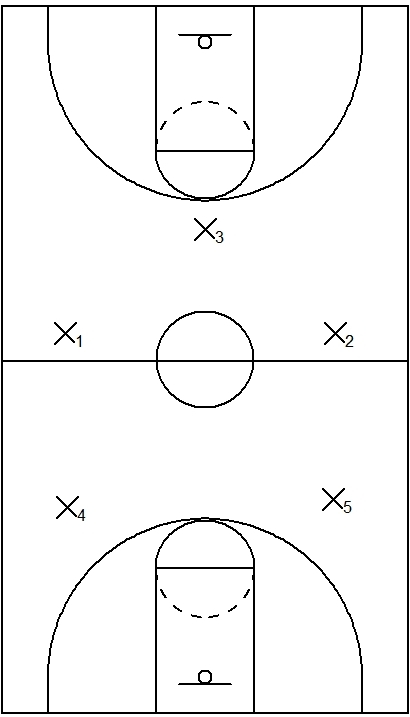
The full court press is a basketball defense system in which players of the defensive team execute backcourt and frontcourt on-ball pressure, typically accompanied by sideline traps against players of the offensive team.
Notable types of full court press defenses include the 1-2-2 press, the 1-3-1 press, and the 2-1-2 press, among others.
The 1-2-2 press defense is a basketball defensive strategy that features moderate defensive pressure and sideline traps, particularly in the backcourt or frontcourt, which in turn, could limit offensive scoring opportunities.
The 1-3-1 press defense is a type of basketball defensive strategy that implements on-ball pressure, particularly in the backcourt, and traps near the sidelines, especially in the frontcourt, to limit or prevent offensive scoring opportunities.
The 2-1-2 press defense is a basketball defensive strategy that implements a modest amount of on-ball pressure, particularly in the backcourt, and sideline traps, especially in the frontcourt, to disrupt the scoring effectiveness of the offensive team with the additional possibility of creating turnovers.